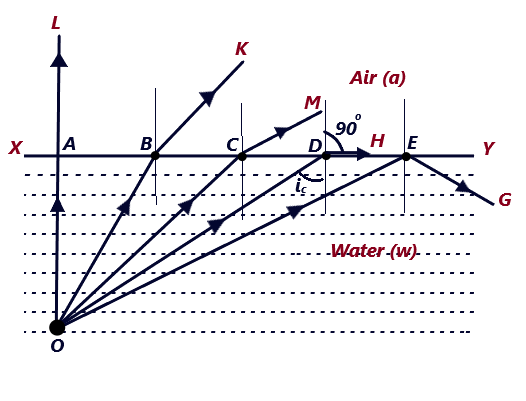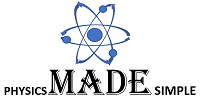Total Internal Reflection
When a light ray is incident at interface backed by a rarer medium at an angle greater than the critical angle, then the ray will be reflected in to the same medium, which is called Total internal reflection-12

Let us consider a surface XY separating the rarer medium air (a) from the denser medium (w) water as shown in the figure. A ray of light OA from object O in the denser medium is incident normally on the surface of separation and gets refracted into the rear medium as such along AL. Another ray of the light incident along the oblique path OB has refracted away from the normal along path BK, in the air as the rarer medium.
As the angle of incidence is gradually increased, the angle of refraction in the air also goes on increasing continuously till for a certain angle of incidence called the critical angle, the refractive ray grazes along the surface of separation. Therefore, the angle of refraction becomes just 90 degrees.
If the angle of incidence is further increased beyond the critical angle, then the light ray will no longer be refracted but will be reflected back into the same medium along the path EG following all the laws of reflection. This is called Total Internal Reflection-12
Therefore, total internal reflection-12 may be defined as the phenomenon of reflection of light that takes place when a light ray traveling in a denser medium gets incident at the interface of the two media at an angle greater than the critical angle for that pair of media.
Critical angle:
The critical angle for a pair of media will be defined as the angle of incidence in the denser medium corresponding to which the angle of refraction is 90 degrees and so, the refracted ray goes along the interface separating the two media.
Conditions for total internal reflection-12:
- The light ray must be incident on the interface after a travel in optically denser medium.
- The angle of incidence should be greater than the critical angle for the given pair of media.
Relation Between Refractive Index and Critical Angle:


Applications of Total Internal Reflection-12
There are a number of optical instruments where the phenomenon of Total Internal reflection-12 is applied to provide the explanation in reference to their working. In addition, it is used successfully in explaining many daily life experiences. The followings are some of the important applications of the Total Internal Reflection-12 phenomenon.
Totally Reflecting Prisms: (Total Internal Reflection-12)
Knowing the fact that there is practically no loss of light energy when it undergoes the total internal reflection-12 contrary to the simple reflection from a mirror, where a small part of light is absorbed. In view of this, totally reflecting prisms are used in various optical instruments in order to change the path of light without the appreciable loss.
Totally reflecting prisms are configured with an isosceles right angled glass prisms having angles 45o – 90o – 45o that are capable to deviate a light ray through 90o or 120o as per the requirements, without loss of light making the use of the phenomenon of Total Internal reflection-12.

Deviation of light through 90o

– Let us suppose that a light ray from a source D strikes the refracting edge AB of the prism at right-angle to it. This light ray after crossing AB un-deviated, meets the refracting edge of the prism BC (hypotenuse) at point E making an angle of incidence of 45o, which is greater than the critical angle for glass-air interface and thus, the light ray suffers total internal reflection at point E of the face BC. The light ray, after the total internal reflection-12 comes to face AC in the direction normal to it, and hence passes the prism without deviation as EF. This shows that the prism has deviated the light ray through 90o
In Michelson’s method to find the velocity of light, the direct light from the octagonal mirror is avoided from direct viewing by making use of totally reflecting mirrors. The totally reflecting prisms are used to produce deviation in the path of light rays through 90o in case the direct view of light is found inconvenient.(Total Internal Reflection-12)

Deviation of light through 180o
When a light ray is made to incident, normally on the hypotenuse, face BC, of the 45o – 90o – 45o glass prisms. The light ray is refracted into the prism without suffering deviation as along PE. The light ray PE suffers a total internal reflection firstly at Point E on the side face BA, and then at the point F on the second face AC.
When the light ray comes to meet the hypotenuse, face BC at right angles to it, then it is refracted out of the prism as such along the path RS. The path of the ray of light has been turned through 180 degrees due to two total internal reflections. By deviating a ray of light through 180o, totally reflecting prisms are utilized Prism-Binoculars in order to an erect image or to correct for the lateral inversion.

Advantages of the totally reflecting prisms over the silvered plane mirrors
- The reflecting prisms do not require any type of silver like reflecting coatings.
- A silvered plane mirror always absorbs sunlight. In the good mirror, the reflection of light is about 90 to 95%. However, in a reflecting prism, almost 100% reflection is secured.
- A thick plane mirror causes multiple reflections. Therefore, along with the image produced due to the first reflection at the silvered surface, several other images are produced due to subsequent multiple reflections. Clearly, the image formed is not very bright. Because in a totally reflecting prism, only one image is formed, so the image obtained by totally reflecting prism is very bright.
- As the mirror is constantly used for a long time, its silver surface may go to the bad condition, then the mirror will produce an image of a very poor quality. However, reflecting prism is free from such a type of trouble.
- The images obtained with the silver coated mirrors are found often distorted due to imperfect and non- uniform silvering of the mirror but in case of reflecting mirrors it is not so.
Mirage– Total Internal Reflection-12

It is an optical illusion observed in deserts and coal-tarred roads on a hot day. An object such as a tree appears inverted, and the observer gets an impression of the presence of water as the inverted image has been formed by a pool of water. This phenomenon is called Mirage.
In summer, due to intense heat, the surface of the Earth becomes quite hot. The air over the earth can be supposed to consist of layers and the temperature of the layer in contact with the surface of the earth is maximum. The temperature of the other layers of the air goes on decreasing as we go up higher and higher as a result, the density as well as the refractive index of the air increases slightly for higher layers. Thus, a ray of light traveling from the point O at the top of the tree, as shown in the figure, passes through air of gradually decreasing refractive index, and therefore gets refracted more and more away from the normal.
Since, the angle of incidence goes on increasing continuously up to a stage, when the angle of incidence becomes greater than the critical angle. At this stage all the conditions necessary for total internal reflection are met and so it takes place. These light rays after suffering total internal reflection at point A as shown in figure reach the eye of the observer and will appears to him as if, coming from the point I hence the inverted image of the tree produces the impression of reflection from a pool of water creating an illusion about the presence of water.
Optical Fibres- Total Internal Reflection-12
John Tyndall, a British Physicist, in 1870, demonstrated that light rays could be made to follow curved paths and this concept gave birth to the optical fibers.
The optical fibers are used to transmit light energy from one place to another place through a curved path in a more effective manner. The optical fibres consist of thousands of strands of very fine quality glass or quartz of reflective index about 1.7 or so. The thickness of a strand is about 10-6 cm. The strands are coated with a layer of some material of lower refractive index, about 1.5. The ends of the strands are polished and clamped firmly after aligning them carefully.
When light is incident at a small angle at one end, it gets reflected into the strands or fibers and gets incident on the interface of the fibers and the coating. The angle of incidence being greater than the critical angle, the ray of light undergoes total internal reflection-12.

It suffers the internal reflections again and again till the angle of incidence exceeds the value of the critical angle for the fibre material with respect to coating. Each fibre acts as a pipe and such a bundle of fibers can be used to convey images along path of any shape. It may be pointed that the optical fibber does not bend light. Instead, light follows the jig jack path through the fibers.
Applications of Optical Fibres- Total Internal Reflection-12
- The optical fibers are used in the field of communication and the computers. They have attained a significant role in transmitting and receiving electric signals. These electric signals before their transmission through optical fibres are converted into light.
- The optical fibers are used for transmitting the optical signals and the two-dimensional pictures too.
- The optical fibers play a significant role in making medical investigations. It uses an optical fiber for this purpose. A doctor can visually examine the inside of the stomach, intestines, etc. using an optical fibre. It is, in medical science called endoscopy.
- The optical fibers in the form of photometric sensors are used for measuring the blood flow in the heart.
- The optical fibers in the form of refractometer are used to determine the reflective indices of liquids.
- The optical fiber sensors have been used to measure temperature and pressure.
The brilliance of diamonds and other precious stones– Total Internal Reflection-12
The refractive index of diamond is 2.47 and the critical angle for diamond air interface is 23o only. On account of the low value of critical angle, a diamond can be cut so as to have a large number of faces. As such, a ray of light on entering the diamond from a face undergoes a series of total internal reflections from other faces, till the angle of incidence inside the diamond remains greater than the critical angle. As a result, it shines very brilliantly.
Summary and Key points-Total Internal Reflection-12
- The necessary and sufficient condition for the total internal reflection to take place is that the light ray should travel from optically denser medium to optically rarer medium and the angle of incidence at the interface must be greater than the value of critical angle for the pair of two media.
- The phenomenon of reflection of light and the phenomenon of the total internal reflection of light are totally different from each other.
